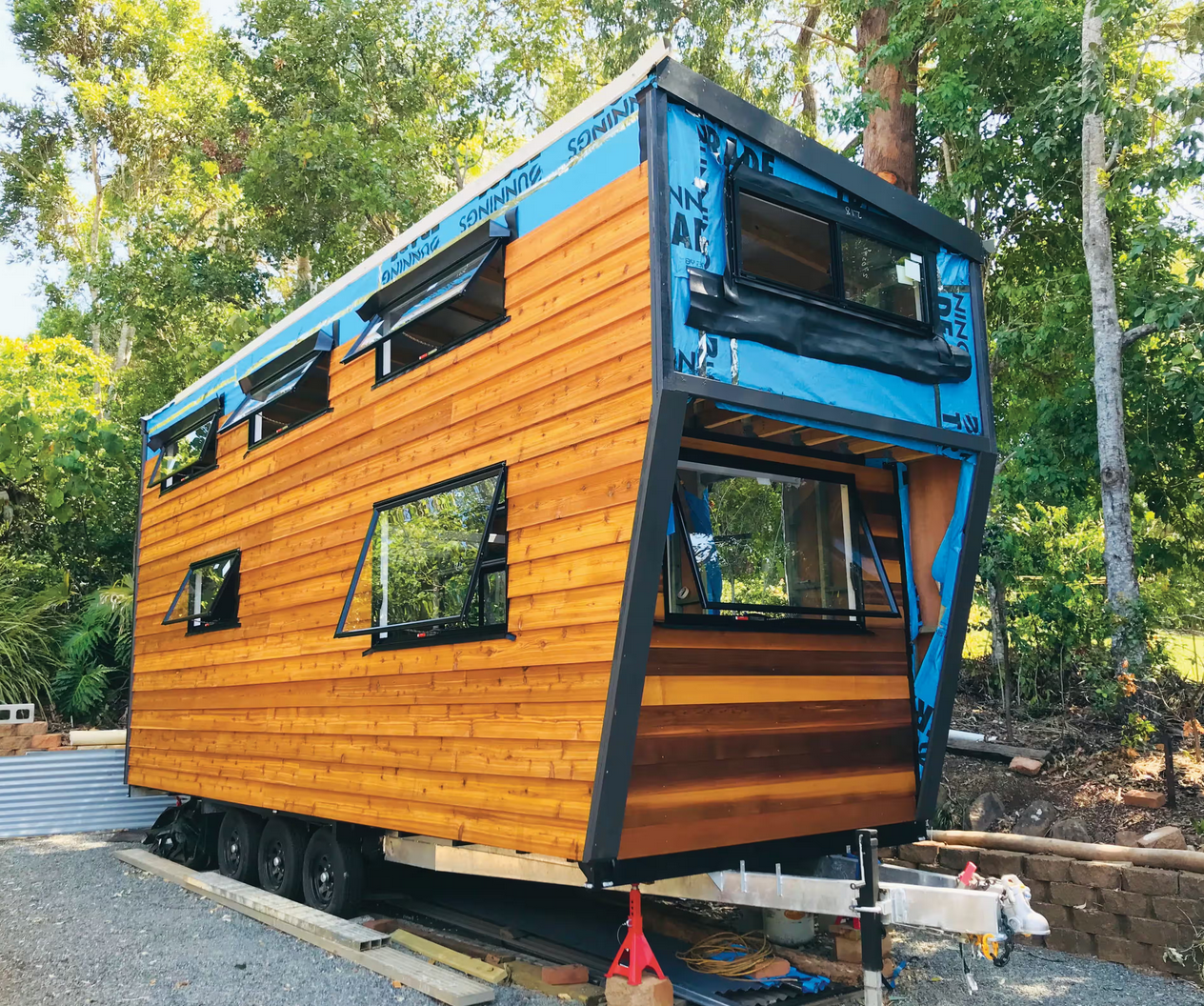The following are excerpts from the book Tiny by Louise Southerden:
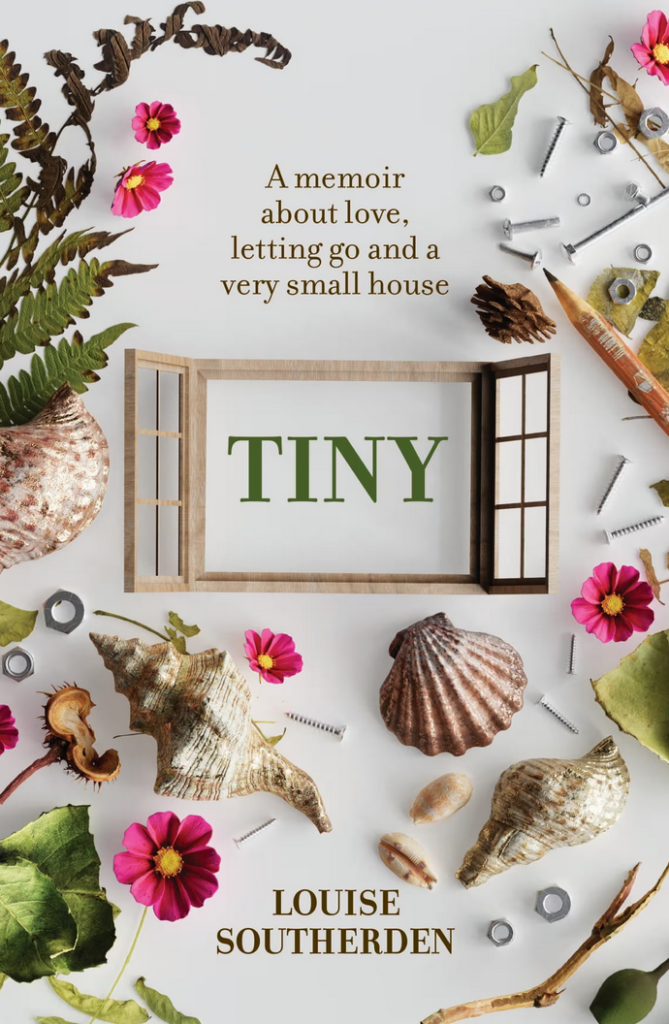 What does it mean to come home? To have a place of your own that feels safe in all the important ways? That wraps its arms around you when you arrive at the doorstep drenched in the problems of the world?
What does it mean to come home? To have a place of your own that feels safe in all the important ways? That wraps its arms around you when you arrive at the doorstep drenched in the problems of the world?
For decades, whenever I thought of home, I didn’t picture the houses I’d grown up in. Instead I thought of places I’d stayed on my travels. Serene hotel rooms, rumbling ships’ cabins, hip-swaying compartments on overnight trains. Small spaces that made me feel safely contained and part of something bigger at the same time.
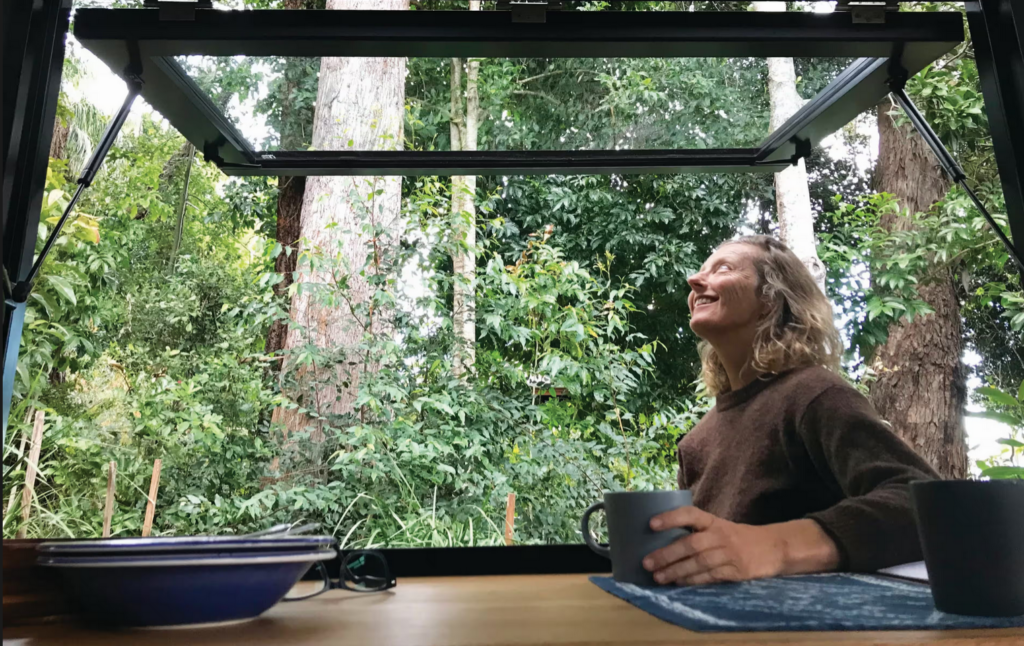 Originally from Sydney, I was living in a studio apartment in a seaside village just south of Byron Bay in northern New South Wales when I first heard about tiny houses. I loved that the Byron area was lush, uncrowded and flanked by dairy farms and pockets of coastal rainforest. And I loved that living in a small town was much more affordable than living in a big city too.
Originally from Sydney, I was living in a studio apartment in a seaside village just south of Byron Bay in northern New South Wales when I first heard about tiny houses. I loved that the Byron area was lush, uncrowded and flanked by dairy farms and pockets of coastal rainforest. And I loved that living in a small town was much more affordable than living in a big city too.
Then the housing crisis spilled out of the cities and started spreading across Australia, pooling in regional areas. Rents increased. My landlady talked about selling the studio I was renting.
Then I turned 50. After successfully managing years of uncertainty in the holy trinity of steadying influences – my living situation, my love life and my work – I started to crave security.
My curiosity started poking its nose into alleyways of alternative housing. I collected articles and bookmarked websites about people who had built small homes cheaply, out of recycled windows or old tyres filled with earth. I did a natural building course, thinking I could build myself a little sustainable dwelling of some kind.
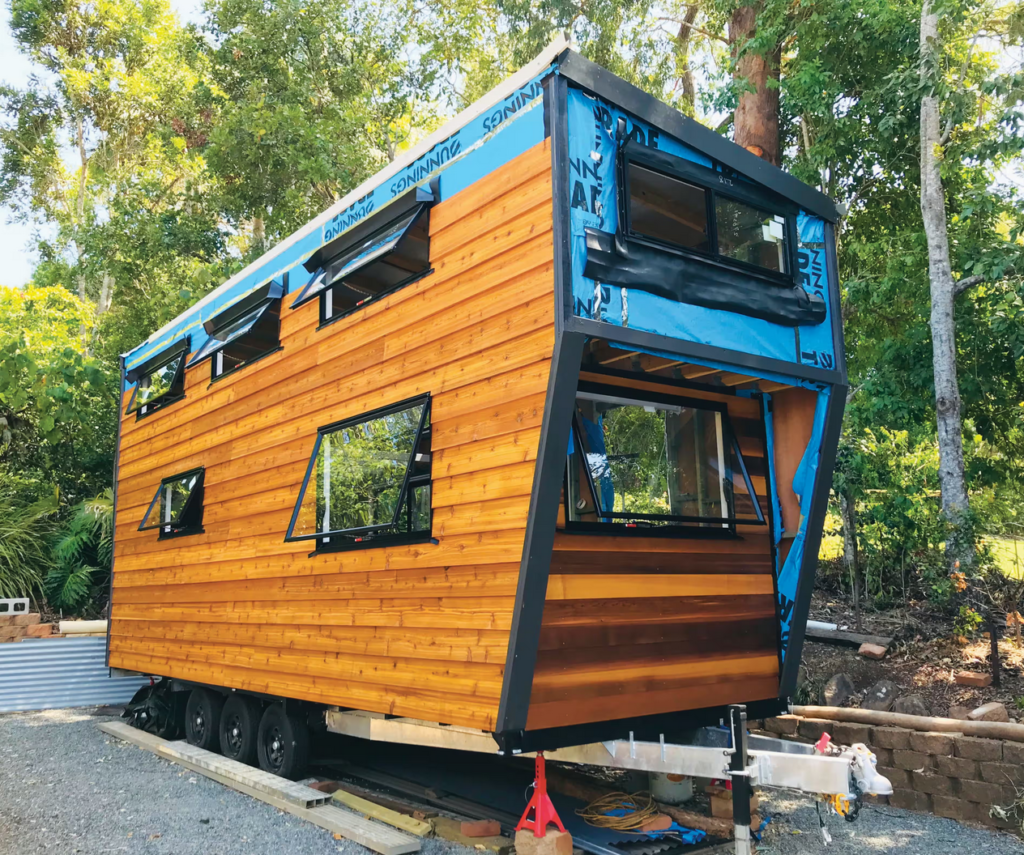 The problem was I had no land, and no money to buy any. Then, a blip on my radar: tiny houses built on trailers. The more I learned about these “tiny houses on wheels”, the more they made sense to me. They were much less expensive than any other kind of house, for one thing, promising liberation from the rental hamster wheel without the financial burden of a mortgage. They were well designed to make the most of a small living space. I loved their built-in sustainability ethos, too.
The problem was I had no land, and no money to buy any. Then, a blip on my radar: tiny houses built on trailers. The more I learned about these “tiny houses on wheels”, the more they made sense to me. They were much less expensive than any other kind of house, for one thing, promising liberation from the rental hamster wheel without the financial burden of a mortgage. They were well designed to make the most of a small living space. I loved their built-in sustainability ethos, too.
Because they were on wheels, tiny houses didn’t require any land-clearing. Because they were small, they needed fewer building materials than regular houses, and less energy to heat and cool. And they encouraged a minimalist mindset; less space meant living with less stuff.
Also, we’re hard-wired to live in small spaces. For most of human history, people have lived in small, simple structures made by hand, from materials close to hand. When we came down from the trees and out of the caves, we moved into huts made of sticks, mud bricks and animal hides; our homes were grass-clad domes, log shacks and stone houses designed to shelter us from the elements, from predators and from other humans. To me, tiny houses were a return to a way of living that could reconnect us with the natural world.
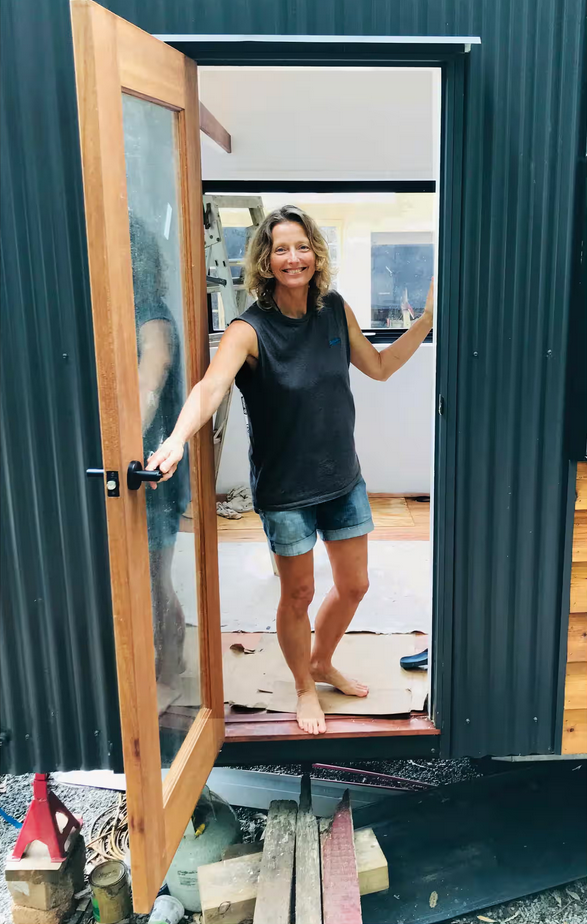 I had no idea yet how it might happen but, for the first time in my life, owning my own home suddenly seemed within reach.
I had no idea yet how it might happen but, for the first time in my life, owning my own home suddenly seemed within reach.
There was one more thing that excited me about tiny houses: you could build one yourself. Fred Schultz, who pioneered the tiny house movement in Australia in 2015, once said: “The tiny house movement is about reclaiming shelter-making … It’s about making use of this little crack in the regulations that allows us to build our own homes and putting the hammer back in the hands of people to reclaim this part of our lives.”
That little crack in the regulations also meant I could draw my own plans; because tiny houses on wheels are classified as vehicles not buildings, the national building code doesn’t apply to them and there’s no need to submit build-ready plans to anyone for approval.
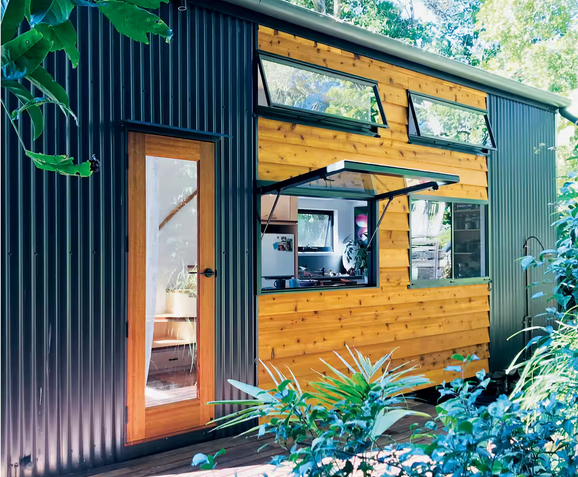 There’s a magnificent sense of possibility when you set out to design and build your own home, no matter how big or small it is. (I settled on a fairly standard 7.2-metre tiny: big enough to be comfortable, small enough to be easily moved.)
There’s a magnificent sense of possibility when you set out to design and build your own home, no matter how big or small it is. (I settled on a fairly standard 7.2-metre tiny: big enough to be comfortable, small enough to be easily moved.)
I began thinking deeply about how I currently lived and what was important to me. Starting with how I was living in my studio.
Where did I spend most of my (non-sleeping) time when I was at home? That was easy: at my desk and on the couch. How much stuff did I need to store? The big items were a couple of surfboards, some camping gear and a few plastic tubs of books. How often did I have visitors, and what did we do together when they came over? I mostly socialized outside my home, but I realized I’d like to have the kind of place I could invite friends to.
 I did a short online design course led by American tiny house architect Macy Miller. She suggested making a wish list of features I had to have in my tiny home.
I did a short online design course led by American tiny house architect Macy Miller. She suggested making a wish list of features I had to have in my tiny home.
First on my wish list: plenty of natural light. I’d lived in too many dark, south-facing houses that were cool in summer, ice-cold in winter and gloomy all year round. Good air flow was vital for keeping the “tiny” as cool as possible during the long, hot summers. Because I work from home, I wanted a dedicated workspace – not one that also served as a dining table or a kitchen bench – so I wouldn’t have to tidy it up or fold it away every night. I’d need a comfy couch that was long enough to serve as a spare bed. I love baking so I wanted lots of bench space. I wanted a kitchen table big enough to read a newspaper, work on a sewing project or have a friend or two over for dinner. In tiny terms, this meant having a long wooden bench that could do double-duty as my kitchen counter and dining area. Thinking ahead, I figured having stairs to my bed loft (a bed loft being another must) would be kinder to my body than a ladder, as I got older; they also offered more storage. And finally, open floor space downstairs, for stretching and doing yoga.
There was one more question my wish list needed to answer: how did I want to feel living in my tiny? I wanted to feel connected to the natural world, to see trees and sky through my windows, to hear the birds in the trees and the rain on the roof. And I wanted it to be beautiful so that I’d feel happy whenever I stepped inside. All within 25 square meters, including the two lofts. So, you know, no pressure.
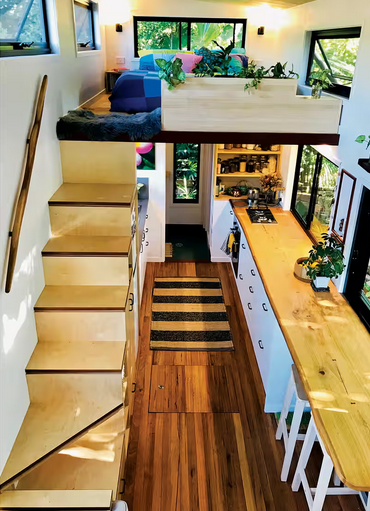 At the end of all this winnowing of ideas, I could almost see my tiny, like a mirage in my mind. It would be a contemporary cabin with as many windows as possible and an all-white interior offset by plenty of timber features.
At the end of all this winnowing of ideas, I could almost see my tiny, like a mirage in my mind. It would be a contemporary cabin with as many windows as possible and an all-white interior offset by plenty of timber features.
Outside, there’d be a deck with an outdoor shower, in addition to my indoor one. And I’d use sustainable/renewable materials wherever I could and go off-grid as soon as possible, starting with a compost toilet, and gas for cooking and hot water (stage two would involve solar panels and a rainwater tank, when finances allowed).
Now I just had to make it happen.
You can read the original article at www.theguardian.com

